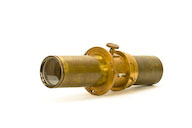
1. Einstein camera lens mount with one lens mounted. The sky-end is to the right.
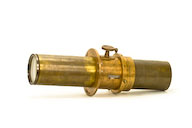
2. Einstein camera lens mount with one lens mounted. The sky-end is to the right.
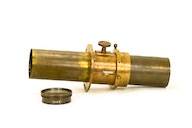
3. Einstein camera lens mount and one lens. The sky-end is to the right.
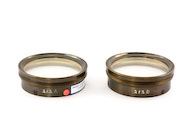
4. Two Brashear doublet lenses, used in combination to form the quadruplet lens of one of the 1922 Einstein Cameras.
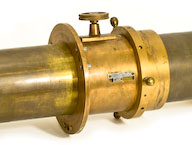
5. Detail showing the collar on the Einstein camera lens mount, with focus wheel, focus scale, and locking screw.

6. End caps for the Einstein camera lens tube.

7. Crate for Einstein camera lens tube, with shipping markings from the 1932 Freiburg, Maine eclipse.

Accession card.
|
|
| Item Name |
Two 5-inch Brashear doublet lenses and their mount, for the Einstein camera |
| Catalog No. |
SO000212 |
| Category |
Lenses and Mirrors : Lenses : Regular (C1a) |
| Description |
Two air-spaced doublet lenses in their cells (designated 212A and 212B), designed by Prof. Hastings of Yale University and made by Brashear and Co. (probably by J. McDowell), along with their brass mounting barrel. Each doublet has a 5-inch aperture and 15-foot focal length; each is in a brass cell approx. 6-inches in diameter and 2-inches high; the doublets have Brashear's characteristic postage-stamp spacers.
The doublets thread to either end of a mounting consisting of a brass tube, 70-cm long and 15-cm in diameter, which is in turn screwed into a wide brass collar. The collar has a flanged at one end for attaching the whole assembly to the camera. Around the collar, a wheel with three brass knobs, can be rotated to move the tube within the collar, along the optical axis, for focusing. The collar includes a scale for reading the focus position, and a large thumb screw for locking the focus. The letters "A" an "B" are stamped into the brass at either end of the tube, indicate which lens is to be mounted at which end (the accession card lists lens "A" as the front component). Two threaded brass end caps and a loose, circular mounting flange (possibly of later manufacture), are also present.
The lenses and mount were made for one of two, matched, 15-foot focal-length cameras used by the 1922 Lick eclipse expedition to Wallal, Australia, to test the deflection of starlight in the Sun's gravitational field, predicted by the General Theory of Relativity. The camera was also used for photographing the corona at the 1932 Fryeburg, Maine eclipse. The lenses and mount of the other camera are catalog number SO000213.
The lenses are described in JRASC (see ADS link below) as "Hastings Brashear quadruplet lenses." The two doublets, A & B, when mounted together in their tube, effectively form a single 4-element, "quadruplet" lens. Note that the accession card lists only the lenses and not the mounting tube. |
| Dimensions |
overall, approximately 75x25 cm. |
| References |
Campbell, W. W. 1922. The Total Eclipse of September 21, 1922. Journal of the Royal Astronomical Society of Canada 16:186-190.
Campbell, W. W. 1923. The Total Eclipse of the Sun, September 21, 1922. Publications of the Astronomical Society of the Pacific 35 (203):11-44.
Campbell, W. W. and R. Trumpler. 1923. Observations on the Deflection of Light in Passing Through the Sun's Gravitational Field, Made During the Total Solar Eclipse of September 21, 1923. Publications of the Astronomical Society of the Pacific 35:158-163.
Moore, J. H. 1932. Crocker Eclipse Expedition to Fryeburg, Maine: The Lick Observatory. Publications of the Astronomical Society of the Pacific 44 (261):341-352.
|
|







